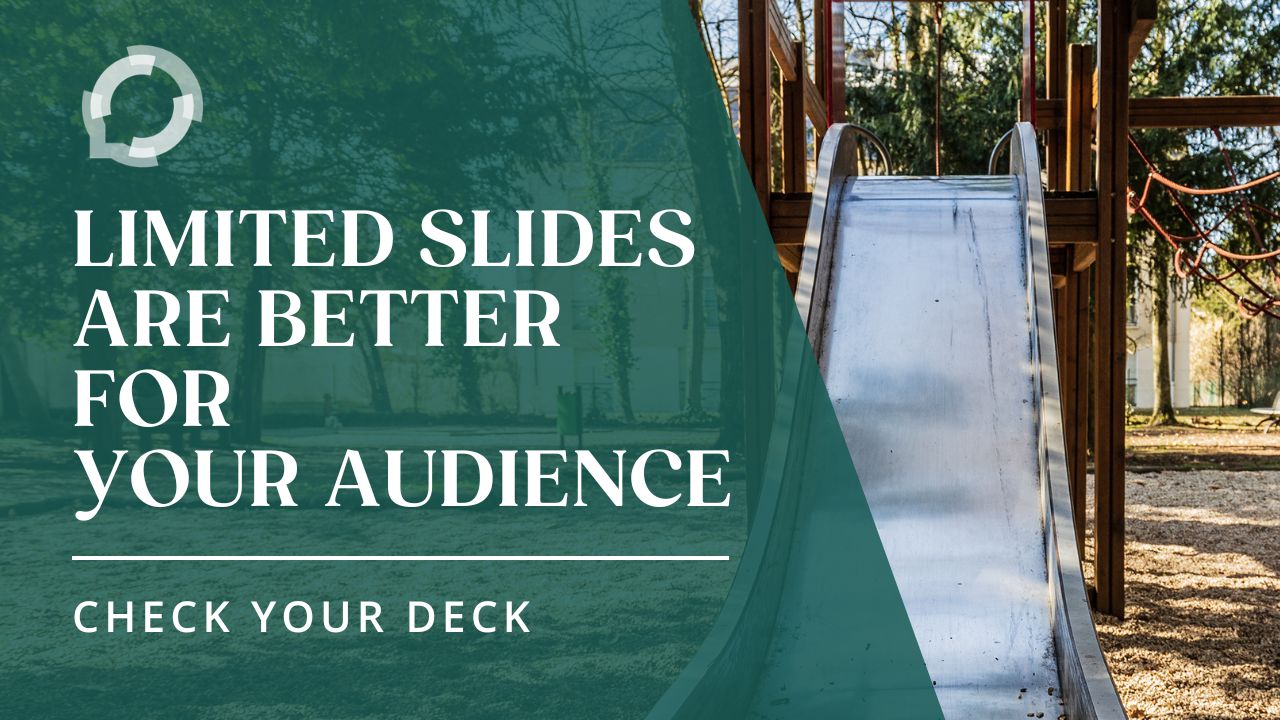A picture is worth a thousand words, so loading your presentation with lots of slides is a great idea … said no one ever.
Visuals have been jazzing up speeches and presentations since the introduction of various software programs in the 1980s, most notably PowerPoint in 1987. Even further back, a generation before computers streamlined presentation technology, carousel slide projectors made it possible to bore large audiences with a series of pictures. If you’ve ever seen a carousel slide presentation, I bet you can still hear the sound of the carousel as it moved, a jerky, clicky, sharp noise, somehow both plastic and metallic.
I’ll talk about whether you even need a deck at all in a future post, but for the sake of this discussion, let’s assume that you do, indeed, need slides. Maybe you’re presenting complicated data that’s easier to visualize than to verbally describe. Maybe you’re presenting to an audience with varying levels of expertise in your topic or whose first language is different from yours; both are groups that can benefit from having slides incorporated into a presentation. Maybe having slides is part of your industry’s standard, and you’re not in a position to opt out of the practice regardless of your personal opinion.
Given that you need to use slides, the big question is – how many?
What’s the Right Number of Slides?
The easy answer is to use exactly as many slides as you need, and no more. Or, as I often say to my writing students when they ask how they should fix problems in their essays, “it depends.” Neither of those are particularly helpful, even if they do have the benefit of being accurate.
You might have heard of the 10/20/30 rule, coined by Guy Kawasaki in 2005: a presentation should have 10 slides, last no more than 20 minutes, and have a font size no smaller than 30. A self-described evangelist for the concept, Kawasaki says that “this rule is applicable for any presentation to reach agreement.”
Rules, though, were made to be broken. Advice on pitch decks range from 8 required slides to an updated list of 11 slides. Sales decks, apparently, are effective at merely 6 slides.
If there isn’t a hard and fast number of slides that works for all decks – and there isn’t – how can you decide? As is very often the case in public speaking and presenting, putting your audience’s needs first points you to how many slides you need.
Put Your Audience’s Needs First
You already know that viewing your deck from the perspective of accessibility can make a huge difference to engaging your audience. Have you also considered the connection between attention span and engagement, that balance between how much time your audience needs to absorb information on a slide and when their focus starts to wander?
A recent study by Alexander J. Simon, et al, (2023) has measured attention span across several age groups. The authors define attention span as the “maximum amount of time that a participant continuously maintained an optimal ‘in the zone’ sustained attention state while performing a continuous performance task.”
Most relevant for this post, young adults (ages 19-32) have an average attention span that’s well over one minute. Although there is a decline in attention span for older adults (ages 56-85), theirs is still longer than a minute. The study does, however, note important limitations on their findings, including the absence of middle-aged adults (ages 33-55) from the study population and the fact that they didn’t study how mood, fatigue, and stress might affect attention span.
With this in mind, that one-minute threshold is a useful guideline for many audiences. If your audience is looking at one slide for much longer than a minute, they’re very likely going to lose focus and stop paying attention to what they’re seeing. You might be tempted to take a packed slide and simply break it into multiple slides with less information on each one. You’ll have more slides, but each one will be easier for your audience to pay attention to, definitely a better choice than one overloaded slide that your audience is unlikely to fully read anyway.
Here’s the key: Your slides aren’t there for your audience to read while you’re speaking. Or worse, for your audience to read along with you as you read the slides aloud. Your slides are there to remind your audience of your main points at that part of the speech or presentation. They don’t have to maintain full attention on the slide at all times; they just need to be able to check in with it. You want your audience to listen to what YOU have to say.
To do that, an even better approach is to use fewer slides, each with 1 to 3 core concepts expressed in the minimum number of words possible.
Check Your Deck
In many ways, building a new deck is easier than trimming an existing one. If you’re starting from scratch, you have the opportunity to suss out specifics of your audience’s needs and use your information in novel combinations.
If you already have a deck, you have to be able to see it in a fresh light. That’s tricky to do, because it’s harder to notice details with familiar content. One technique that can help break that connection is to take a first pass through your deck in reverse order. Starting with the last slide interrupts your brain’s ability to fill in what it’s expecting to see.
Whatever sequence you use for reviewing your deck, be rigorous in asking yourself what the function of each slide is and why it’s at that point in the presentation. Be ruthless about removing duplication. Consider, for example, whether you can provide additional context, research, or background information in a different format after you conclude the presentation.
And while I’m sort of on the topic, be really mindful about how you move between slides. A selective and consistent use of transitions or to shift audience focus within a slide is very effective. Avoid using a wacky series of transitions just for visual “interest.” It’s the slide deck equivalent of Macromedia Flash animation from the mid 1990s – very cool the first time you see it, with rapidly decreasing value that quickly turns into annoyance. Flash is gone, and with any luck, so too will the flash slide transition soon be.
How About You?
How do you decide how many slides to use in your deck? Do you have a sweet spot, a number that generally works for your audiences? How did you come up with it? If you had a longer deck and cut it down, what got left behind?As an audience member, what’s the longest deck you’ve had to endure? The worst slide deck sins? Have you ever found yourself hoping for a massive power outage just to finally stop a deck that’s way, way too long?
Tell us about it in the comments.
Check Out Our YouTube Channel
The Rourke Training – Ongoing Mastery YouTube channel has a bit of something for everyone. Go there to get Kirsten’s take on examples of public speaking, as well as reflections on her entrepreneurial journey. The channel is also the home of the podcast Kirsten and Kellie produced for 5 years, Ongoing Mastery: Presenting & Speaking, which covers everything connected to continually improving your craft of being a public speaker, from interviews and mini-coaching sessions with guests to conversations between Kirsten and Kellie.
Come join us. Cheers, Kellie


